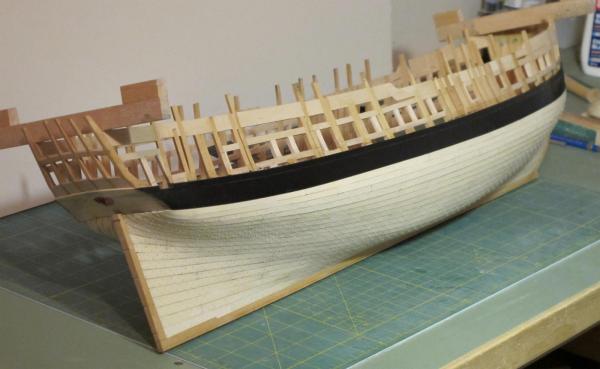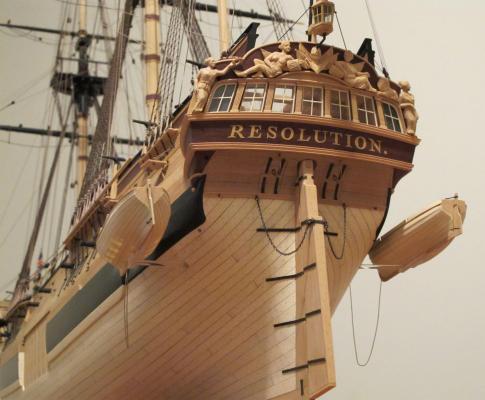-
Posts
13,336 -
Joined
-
Last visited
Content Type
Profiles
Forums
Gallery
Events
Everything posted by druxey
-

British 'Termagant', 1780, ship-rigged Sloop - Info?
druxey replied to malachy's topic in Nautical/Naval History
Now, Termagant is an interesting subject. I came across her sheer and profile plan many years ago and noticed that it shows a very early example of 'plug stock' rudder. Notice how the stern post is sloped away at the upper end so that the upper part of the rudder can turn in a small, circular helm port. This style of rudder was generally adopted by the Navy only some 25 to 30 years later. This alone will make her an extremely interesting model. -

How would you improve your Byrnes tools?
druxey replied to Keith_W's topic in Modeling tools and Workshop Equipment
Having read and looked at the examples of modifications on this thread, it seems that each person has his/her own preferences. All Byrnes needs to do is pre-drill and tap accessory holes of a standard thread on their machines, then everyone can then bolt on their own devices. -
Where were pump dales stowed when not in use? Great question. My guess is overhead, between two deck beams. However, if anyone has good contemporary evidence, I'd love to know.
- 1,449 replies
-
With all due respect, the planking expansion shows the pattern of planks, but they are distorted in the projected view. For instance, in the topside of the illustration of Squirrel, the midships planks actually curve in the opposite direction ('smiley'). Otherwise, virtually all the hull planks are cut on a curve, as you say.
-
Whoever effected that 'repair' should be strung up from their own yard arm! I suppose they thought that no-one would ever notice??? And in a museum yet. Unbelievable. Anyway, Mobbish, best wishes for a proper restoration of what was once a very nice model.
- 21 replies
-
The other tip to prevent shrouds from bowing out or in is to tie every fifth ratline first, then add the intermediate ones.
-
If not from battle damage, certainly from high seas and storm conditions!
- 889 replies
-
Looks good, Ben. Take Greg and Toni's advice, though: we've all had that experience, although it was another model maker who damaged the framing of one of my models....
- 889 replies
-
You've managed that tricky area at the transoms well, Christian!
- 102 replies
-
Much, much improved, certainly, Mark. Perhaps even a tad more, if there is enough wood remaining to do so. You'll be glad you did this, and you'll find reinstalling the planking will be much easier.
-
Further to the raised beakhead platform issue: The original beakhead was part of the upper deck. It aligned with the lowest point of the main rail of the head in the ship as originally built. This headwork was rather old fashioned and deep. When the headwork was replaced with a higher 'modern' one, the main rail was also constructed at a higher level and the additional platform added to line things up again. You can see this on the original draught and compare this to the ship as she now is.
-
Mark: if you have been working from Hahn's drawings, the problem lies with his drafting, not your construction accuracy. I've noticed this issue with other Hahn models and ones built from his plans. Cold comfort for you, but....
-
Mark: there is a fairing issue at the stern here (perhaps I'm coming in on this conversation a little late). The curve should be nicely radiused, without any sudden turn. I've attached two examples here: one is a full-bodied ship, the other lean and mean. Hope this is of some help.
-
Yes, one does! Otherwise paralysis sets in....
- 346 replies
-
- terror
- polar exploration
-
(and 2 more)
Tagged with:
-
Great stuff, E&T. It's always a little frustrating having to 'best guess' things. I've often found that I was right on later when more information came to light. I hope you have the same experience. Looking forward to seeing your progress, particularly as you layer it on at the bow. Just checked out your blog: excellent commentary and pictures!
- 346 replies
-
- terror
- polar exploration
-
(and 2 more)
Tagged with:
About us
Modelshipworld - Advancing Ship Modeling through Research
SSL Secured
Your security is important for us so this Website is SSL-Secured
NRG Mailing Address
Nautical Research Guild
237 South Lincoln Street
Westmont IL, 60559-1917
Model Ship World ® and the MSW logo are Registered Trademarks, and belong to the Nautical Research Guild (United States Patent and Trademark Office: No. 6,929,264 & No. 6,929,274, registered Dec. 20, 2022)
Helpful Links
About the NRG
If you enjoy building ship models that are historically accurate as well as beautiful, then The Nautical Research Guild (NRG) is just right for you.
The Guild is a non-profit educational organization whose mission is to “Advance Ship Modeling Through Research”. We provide support to our members in their efforts to raise the quality of their model ships.
The Nautical Research Guild has published our world-renowned quarterly magazine, The Nautical Research Journal, since 1955. The pages of the Journal are full of articles by accomplished ship modelers who show you how they create those exquisite details on their models, and by maritime historians who show you the correct details to build. The Journal is available in both print and digital editions. Go to the NRG web site (www.thenrg.org) to download a complimentary digital copy of the Journal. The NRG also publishes plan sets, books and compilations of back issues of the Journal and the former Ships in Scale and Model Ship Builder magazines.




